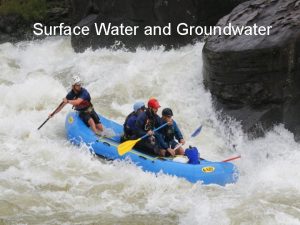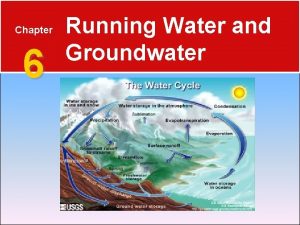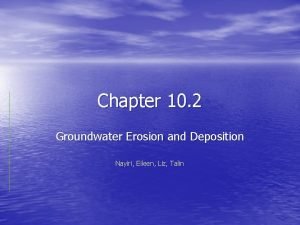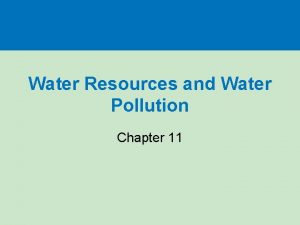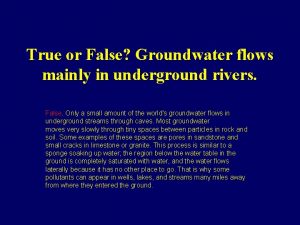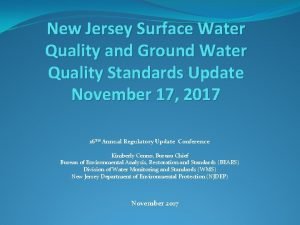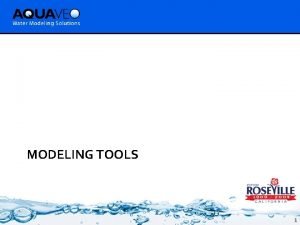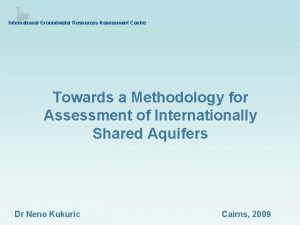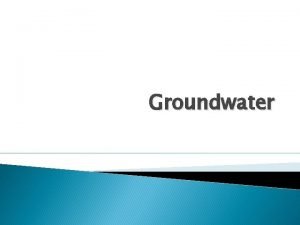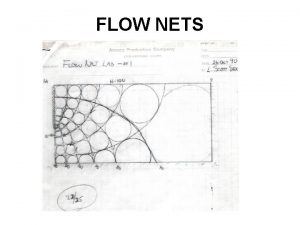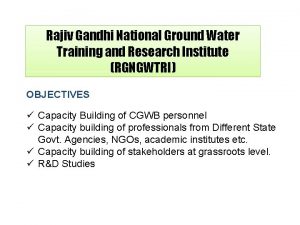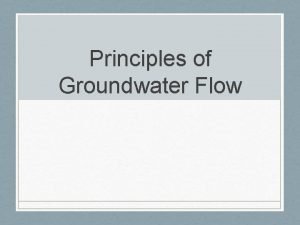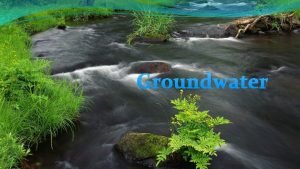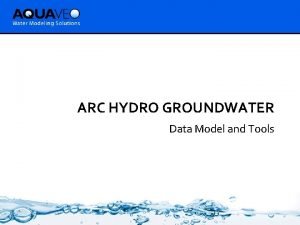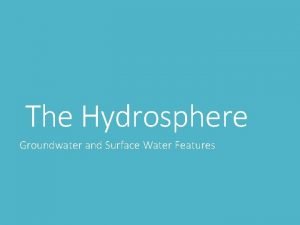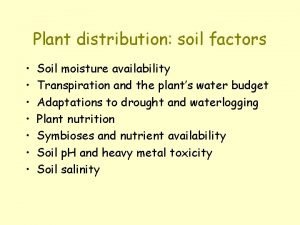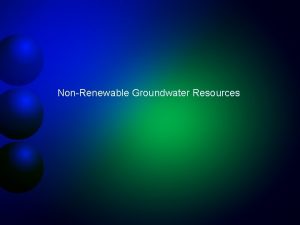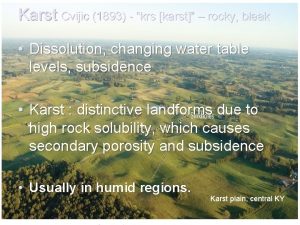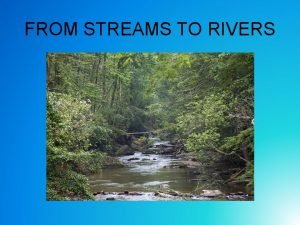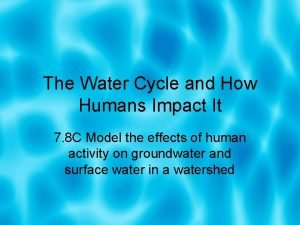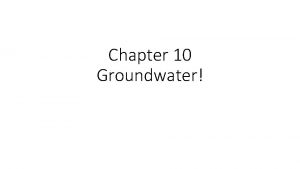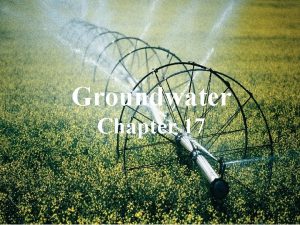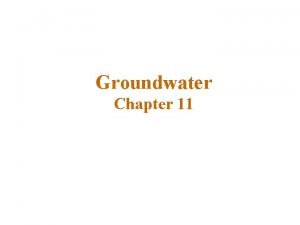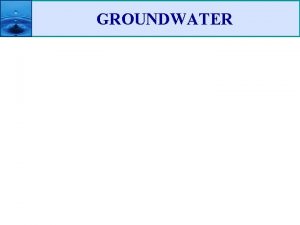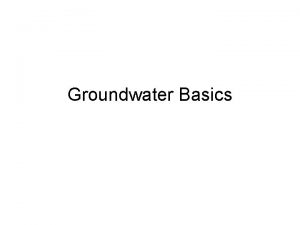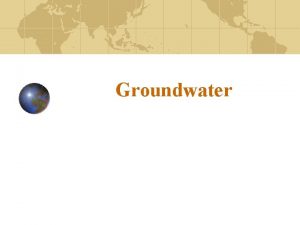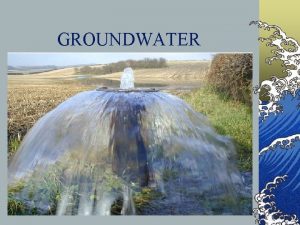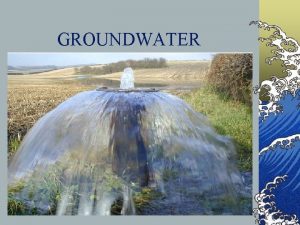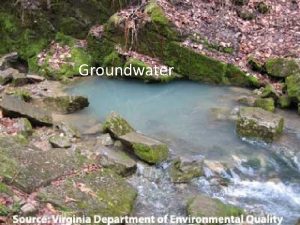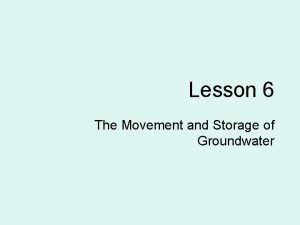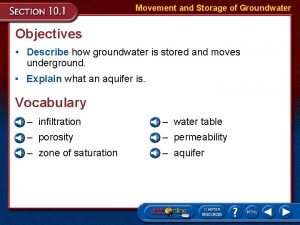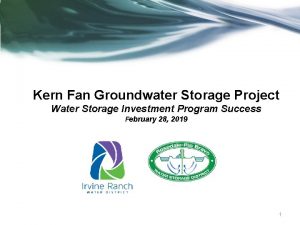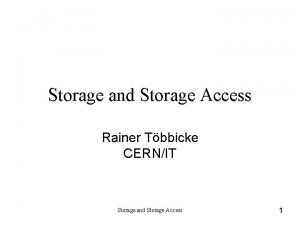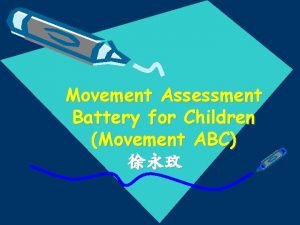Groundwater Section 1 Movement and Storage of Groundwater

































- Slides: 33

Groundwater Section 1: Movement and Storage of Groundwater Section 2: Groundwater Weathering and Deposition Section 3: Groundwater Supply

• Section 1: Groundwater reservoirs provide water to streams and wetlands wherever the water table intersects the surface of the ground. • Section 2: Chemical weathering of limestone by water causes the characteristic topography of karst areas. • Section 3: Water is not always available in the quantities and in the locations where it is needed and might be compromised by pollution.

Section 1 – Movement and Storage of Groundwater • Essential Questions: – How do groundwater storage and underground movement relate to the water cycle? – How are aquifers and aquicludes related? – How are the components of aquifers related to the presence of springs?

The Hydrosphere • The water on and in Earth’s crust makes up the hydrosphere. • About 97% of the hydrosphere is in the ocean. • Freshwater is one of the Earth’s most abundant and important renewable resources.

Groundwater and Precipitation • The ultimate source of all water is the oceans. • Evaporation from the oceans cycles into the atmosphere. • Winds and weather moves the moisture all over the world. • Infiltration is the process by which precipitation that has fallen on land trickles into the ground.

• Groundwater moves slowly through the ground. • Water seeps into the ground through pore spaces. • The greater the porosity the more water can be stored.

• Zone of saturation is the area below the Earth’s surface in which the groundwater completely fills all the pores of a material. • The upper boundary is the water table. • The zone of aeration is above the water table where materials are moist but not wet.

Water Movement • Water can move through the ground by gravity or capillary action. • Gravitational water is water that trickles down due to gravity. • Capillary water is water that is drawn upward like a paper towel absorbing water.

• The depth of the water table will vary depending on local conditions. • In wet areas the water table will be close to the surface. • In hilly areas the water table will be tens or hundreds of meters down. • The water table will fluctuate based on the weather conditions.

• Groundwater flows downhill. • The water flows slowly based on the permeability of the ground. • Sand gravel will allow the water to pass easily. • Aquifers are underground water storage areas that allow the water to pass through. • Aquicludes prevent the flowing or water.

• Springs occur where the water table intersects with Earth’s surface. • Groundwater will emerge and flow from the ground. • The amount of water may be a trickle or it might be enough to form a stream.

• Hot springs have a temperature that is above 36. 6°C. • A human’s average body temperature is 37°C. • There are thousands of hot springs in the U. S. due to igneous activity. • Geysers are explosive hot springs. • Old Faithful is a geyser located in Yellowstone National Park in Wyoming and erupts every 35120 minutes and can reach heights of 27 -55 m.

Old Faithful Erupting • https: //www. youtube. com/watch? v=w. E 8 NDu zt 8 eg

Section 2 – Groundwater Weathering and Deposition • Essential Questions: – How does groundwater dissolve and deposit rocks and minerals? – How do caves form? – What features are characteristic of karst topography?

• Carbonic acid forms when carbon dioxide gas dissolves in water and combines with water molecules. • Carbonic acid causes groundwater to be slightly acidic. • The slightly acidic water attacks limestone to break it down over time.

• Carbon dioxide and water combine to form carbonic acid. • Carbonic acid splits into hydrogen ions and bicarbonate atoms. • Hydrogen ions react with calcite to form calcium ions and bicarbonate ions.

• The reaction is as follows: CO₂ + H₂O → H₂CO₃ → H⁺ + HCO₃ˉ Ca. CO₃ + H⁺ → Ca²⁺ + HCO₃ˉ

• Caves are natural underground openings. • Most caves are formed when the groundwater dissolves limestone. • Karst topography is a landscape characterized by a landscape of sinkholes formed from the dissolution of limestone. • A sinkhole is a depression in the ground caused by the collapse of a cave.

• Karst topography is common in Kentucky, Indiana, Florida, and Missouri. • The Mammoth Cave in Kentucky contains tens of thousands of sinkholes.


Groundwater Deposits • Calcium ions precipitate from groundwater and form new calcite minerals. • These minerals create dripstone. • These features are created over time from the drip of calcite rich water. • Stalactites are dripstones that hang from the ceiling of caves. • Stalagmites are dripstones that form on the ground from drips from stalactites.

• Over time stalactites and stalagmites will meet and form dripstone columns. • Hardwater is water that contains dissolved solids such as calcium, magnesium, and iron.


Section 3 – Groundwater Supply • Essential Questions: – How is groundwater withdrawn from aquifers? – What are the major problems that threaten groundwater supplies?

• Well are holes dug down into the ground to reach an aquifer. • Ordinary wells are dug down to the water table. • As water is drawn out it is replaced by surrounding water. • If too much water is withdrawn it will cause shallow wells to become dry.


• Water from precipitation will replace water that is taken out. • This is called recharge. • Artesian wells can spurt water above the land surface. • A spring that discharges pressurized water is called an artesian spring.

Artesian Well and Spring

Threats To Our Water Supply • Freshwater is a precious natural resource. • Human demand for freshwater is enormous. • An important aquifer in the U. S. is the Ogallala Aquifer that covers areas from South Dakota to Texas. • Water from this aquifer is used to water crops grown in these areas. • The water is not being recharged as quickly as it is withdrawn.

• Overuse – groundwater is pumped out at a greater rate than recharged. • Subsidence – excessive withdrawal of water causes the sinking of land. • Pollution in groundwater – when the recharge areas of an aquifer are contaminated, the groundwater is contaminated.

• Sources of groundwater pollution includes faulty septic tanks, farms, landfills, and waste disposal sites. • Chemicals can travel through the smallest pores. • Chemicals can contaminate any aquifer. • In coastal areas salt from ocean water can contaminate wells.

• Radon is a gas that is known to cause lung cancer. • It is found in groundwater due to natural radioactive decay within rocks. • Radon gas can also accumulate in basements.

• Protecting our groundwater should be a concern for us. • We should be aware of what we put onto the ground because it can make its way into our water.
 Secondary storage vs primary storage
Secondary storage vs primary storage Secondary storage vs primary storage
Secondary storage vs primary storage Non movement area
Non movement area Secondary storage provides temporary or volatile storage
Secondary storage provides temporary or volatile storage Object based and unified storage
Object based and unified storage One is not an example of axial movement.
One is not an example of axial movement. Running water and groundwater
Running water and groundwater Chapter 6 running water and groundwater
Chapter 6 running water and groundwater Groundwater erosion and deposition
Groundwater erosion and deposition Farmers and the populist movement section 3
Farmers and the populist movement section 3 Farmers and the populist movement section 3
Farmers and the populist movement section 3 Chapter 13 section 3 farmers and the populist movement
Chapter 13 section 3 farmers and the populist movement Warehouse management structure
Warehouse management structure Ground water pollution
Ground water pollution How to help reduce water pollution
How to help reduce water pollution Groundwater true/false quiz answers
Groundwater true/false quiz answers Njdep groundwater quality standards
Njdep groundwater quality standards Gms groundwater
Gms groundwater Groundwater assessment methodology
Groundwater assessment methodology Water table
Water table Septic tank contamination groundwater
Septic tank contamination groundwater Groundwater flow net
Groundwater flow net Water erosion and deposition
Water erosion and deposition Water cycle brain pop
Water cycle brain pop Rgngwtri
Rgngwtri Bernoulli equation groundwater
Bernoulli equation groundwater Groundwater porosity
Groundwater porosity Arc hydro groundwater
Arc hydro groundwater On the surface of water
On the surface of water Groundwater table
Groundwater table Why is groundwater a nonrenewable resource
Why is groundwater a nonrenewable resource Karst topography diagram
Karst topography diagram How does groundwater rejoin the water cycle
How does groundwater rejoin the water cycle Human impact on groundwater
Human impact on groundwater






